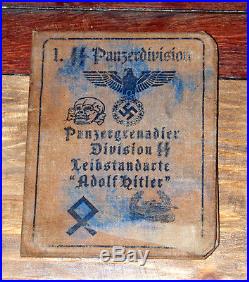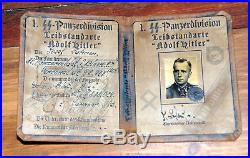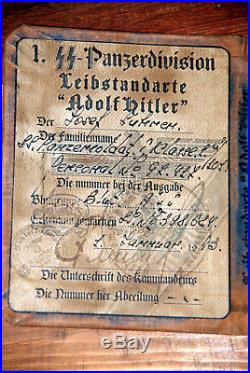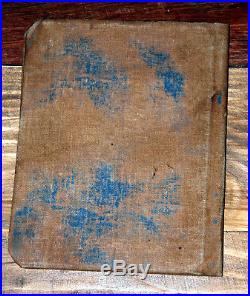1st SS-Panzer-Division Leibstandarte SS Adolf Hitler id






1st SS-Panzer-Division Leibstandarte SS Adolf Hitler id. Will not send to Australia!!
The 1st SS-Panzer-Division Leibstandarte SS Adolf Hitler (LSSAH) was formed in 1933 as a premier SS regiment that served as an elite bodyguard and security force to the Führer that later became a division. Long before the NSDAP came to power in 1933, during the formative years of its existence, the elite of the party had formed special units whose sole purpose was to guard and protect those in command. The first record of any such unit was in the early days of the party when men of the 19th Trench Mortar Company, under the leadership of Ernst Röhm, acted as a body guard unit during the first demonstrations and speeches by Hitler and other party members. This first grouping of men eventually was formed into the Sturmabteilung, or SA, which quickly began to grow. From the very beginning, Hitler viewed the SA as a potential threat as well as a useful tool.
As a means to offset the growing power and potential threat of the SA, Hitler ordered the formation of special unit to be made up of loyal followers that would protect the NSDAP leadership. This special unit was formed with Julius Schreck and Joseph Berchtold as its members, and was named the Stabswache.
Although this new formation was a unique and separate cadre, it was still under the ultimate control of the SA. From its initial formation, the Stabswache was designed to be separate from the SA, even if still under its control. To this end, the basic uniform and insignia of the Stabswache were designed especially for the men of the unit, consisting at this time of the very first use of the Totenkopf, or Death's Head, on the caps of the men, as well as a number of other specific elements, unique to the Stabswache. Soon after formation, the Stabswache was renamed as the Stosstrupp Adolf Hitler.
On November 9th, 1923, the Stosstrupp Adolf Hitler, along with the SA and other NSDAP formations, took part in the attempted Putsch in Munich against the Weimar Republic. The Putsch failed and Hitler was jailed along with many other members, and the NSDAP was banned.
The Stosstrupp Adolf Hitler was officially disbanded, as were all the formations of the NSDAP. The SA would continue to exist after the NSDAP was disbanded though, although under a new name, the Frontbahn, which was led by Ersnt Röhm while much of the rest of the leadership was in prison. Under Röhm's leadership, the SA began to grow substantially, from about 2,000 members before the abortive Putsch in November of 1923, to nearly 30,000 soon after. When Adolf Hitler was released from jail in December of 1924, a rift had formed between Hitler and Ernst Röhm over the direction and the future of the SA. This rift would eventually lead to the murder of Röhm during the figurative beheading of the power structure of the SA in 1934, during the "Night of the Long Knives" in which a number of SA leaders were eliminated.
As a result of this move, the SA, a once powerful paramilitary political force in the NSDAP structure, was rendered impotent. This move would, in 1934, give the SA's rival at the time, the SS (At this point in our story still unformed), the go-ahead to take center stage of the political and paramilitary aspects of the NSDAP, and by very extension, of the German Nation.Soon after Hitler was released in 1924, a new unit was formed along the same lines as the original Stabswache and Stosstrupp Adolf Hitler. This new formation was once again named the Stabswache, but it was not formed under control of the SA, but as a completely separate unit. The new Stabswache was to consist of ultra devoted followers that could be relied upon under any circumstances to protect the NSDAP leadership and Hitler himself. Shortly after the formation of the new Stabswache, it was renamed as the Schutzstaffel.
With the formation of the Schuzstaffel in 1925 there existed two competing and separate paramilitary political organizations within the NSDAP, The SA and the SS. It is from this point that the history of the Leibstandarte truly begins. After the formation of the SS in 1925 it experienced a great deal of growth. The expansion of the SS is a highly complex and very detailed topic though, and this is not the focus of our study of the Leibstandarte formations.With a basic understanding of the initial formations of the various body guard and protection units up to 1925, ending in the creation of the SS itself, and of the difference between the SA and the SS, we are prepared to enter into a discussion of the formation and growth of the actual Leibstandarte units of the SS. In 1933, 8 years after the initial formation of the ss, it had grown to nearly 50,000 members.
It was at this point in the history of the Schutzstaffel, in the Sping of 1933, that a move was made to form an elite unit within the already elite ss. This elite of the elite was to be a new, special body guard unit, formed from hand picked SS men, to act as the special body guard of Hitler, and to be responsible only to his wishes. This new unit was named the SS-Stabswache Berlin. Shortly after its formation, later in 1933, it was redesignated as the SS-Sonderkommando Berlin. Two other SS-Sonderkommando units were formed in the early summer of 1933, SS-Sonderkommando Zossen and SS-Sonderkommando Jüterbog.
These two Sonderkommandos functioned as training cadres for the SS, as well as in the role of auxiliary police units until that function was later dissovled. Both units were later absorbed into the SS-Sonderkommando Berlin in 1933, at which time, its designation was changed once more to the Adolf Hitler-Standart. On November 8/9th, 1933, the 10th anniversary of the failed Munich Putsch, the entire Adolf Hitler-Standarte took part in a mass oath taking rally, in honour of those killed in the 1923 uprising. The rally took place at the location of the Feldherrnhalle, erected on the spot where many of the party members had been killed during the Putsch. During this rally, each member personally swore his life to the Führer. Also during this rally, the unit was again renamed, this time as the Leibstandarte SS Adolf Hitler. In 1934, by order of Himmler, the initials "ss" were added to the Leibstandarte's title, thus becoming the Leibstandarte SS Adolf Hitler. Then, in late June of 1934, the Leibstandarte SS Adolf Hitler was called into serious action for the first time. As a result of a the political situation that had been growing within the NSDAP over Ernst Röhm and his stated desire for a second revolution in Germany, with the ultimate creation of a true "People's Army" in place of the regular armed forces, a move was made to remove the problematic heads of the SA. This action culmintated in what is known as Die Röhm Affäre and the Night of the Long Knives. For its part in the move to quell the real and imagined threat within the ranks of the SA, two companies of the LssAH were organized under the control of Otto Reich and Jürgen Wagner. They were transfered from their barracks in Berlin to the countryside, and then to Munich, arriving there on the afternoon of the 30th of June. From there, a small group of men from the 2 companies present were sent to the Stadelheim prision to take part in the death by firing squad of a group of SA men who had been arrested and charged with treason and attempting to overthrow the State. The orders given to these men and the men of the LSSAH were followed without question, as they were expected to do by Hitler and leaders of the SS.Most of the men of the LSSAH actually remained in their barracks in Berlin during this time, only 2 companies being sent to Munich, but during the time of the Röhtm Affair, other small groups of men were selected from those still in barracks to take part in the killing of other various accused. When the Röhrm Affair was officially over on the 13th of July, 1934, around 177 people had been executed and the SS had become a independent organization, no longer subordinate to the SA, and the wishful and seemingly problematic SA leader, Ernst Röhm, had been eliminated. On the 26th of February, 1935, a small group of LSSAH men were sent into the Saarland as an advanced group, and soon after, on the 28th of February, the 5. Btl, along with the Bataillone stabs, were sent into the Saarland to take part in the festivities marking the recent return of the Saarland to Germany. Later on the 1st of March, other units of the LSSAH joined the rest of their unit in the Saarland.
After the Polish Campaign, the LAH was pulled back into Germany for rest and refitting. The LAH then took part in the Western Campaign, first against the Low Countries and then against France. The LAH was initially in Army Reserve, while one of its motorcycle battalions linked up with the Fallschrimjager troops that had jumped into Rotterdam. After a lull in action for the LAH, it fought against the shrinking beach-heads of the evacuating British Army at Dunkirk, but were only able to maintain pressure against their lines.
During the second phase of the Campaign in France, the LAH was once again organized as an independent regiment, this time under 14 Armee Korps (mot). 14th Armee Korp initially attacked south from a bridge-head at Amiens, but was stopped by severe French resistance. After limited successes and little advance, the 14th Armee Korp was withdrawn and transferred 75 miles to the East. This time the attack was very successful and the 14th Armee Korps rapidly advanced, crossing the Seine River, and moving to cut the retreat of numerous French units at Loire. After the Armistice was signed ending the Campaign in the West, the 14th Armee Korps continued down the French coast to the border with Spain, securing the rest of occupied France. After the Campaign in France ended, the LAH was stationed in France for rest and refitting.Initially, the LAH was going to be given a partial lead role in the planned invasion of England. To prepare for the upcoming invasion, the LAH trained extensively in amphibious warfare. In August, 1940, the LAH was raised to brigade status, although its title did not reflect this change. The invasion of England was canceled, and in March of 1941, the LAH was moved to Rumania where it was to take part in the invasion of Yugoslavia and Greece. Now under the 40th Armee Korps, the LAH first broke into Yugoslavia, met the retreating Italians (Who the Germans were now rescuing), and then moved into Greece.
The LAH then used a number of flanking maneuvers that continuously pushed the British further south into Greece, literally chasing them through Greece in 18 days. The LAH then crossed the Gulf of Corinth in fishing boats rather than follow the British to Thermopylae and managed to meet the retreating Allies on the Peloponnesus. By the end of April, the British had been forced into another situation like that at Dunkirk, this time at Kalamata, where they barely managed to retreat to the Island of Crete. After the successful Campaign in Yugoslavia and Greece, the LAH was refitted and brought up to Divisional status, but only in name, and then attached to the 54th Armee Korps for the invasion of the Soviet Union. The LAH was part of Amy Group South, and as such, did not itself see combat until it was used to assault the Tarter Ditch blocking the way into the Crimea. Next, LAH was transferred to Panzer Group 1 to take part in the massive encirclement of the Kiev Pocket. Still under Panzer Group 1, the LAH then took part in the drive on Rostov. The LAH took Rostov, but was forced out by Soviet counter-attacks, pushing the LAH back across the Mius River where it set up defensive positions.In the Summer of 1942, the severely mauled LAH was pulled back to Paris to refit, and was upgraded to a Panzer-Grenadier Division in name, although it had the strength of a full Panzer Division at the time. In 1943, the LAH was again recalled to the East Front where it took part in the massive battles for the recapture of Kharkov and in the largest tank battle in History during the epic struggle for Kursk in the Kursk Salient. After being stopped by fierce Soviet resistance in the Battle for Kursk, the LAH was pulled out and moved to Italy to be used in anti-partisan operations.
Reequiped and renamed as a full Panzer Division the LAH was sent to rescue the crumbling situation on the Eastern Front. Another massive Soviet Winter offensive then managed to encircle the LAH, and a counter-attack by the II. SS-Panzer-Korps rescued the nearly destroyed LAH from certain death. Once again, the LAH was moved to France for rest and refitting.
After the D-Day invasion by the Allies on the Normandy coast in June, 1944, the LAH was committed in August to fighting in Caen, Falaise and Argentan. Continuously pushed back, the LAH was brought back behind the Siegfried Line in Germany. Parts of the LAH where then committed to the Battle for Aachen. In December, 1944, the LAH was attached to the I SS Panzer Korps for the Attack in the Ardennes region of France. Highly successful in that attack, elements of the LAH Panzer Division, namely Kamfgruppe Pieper, punched nearly all the way to the Meus River, being stopped only by blown bridges, lack of supplies and Allied Air power. After the failed attempt to punch through the Ardennes in France, the LAH was moved one last time to the East to confront the Soviets, this time in Hungary, and took part in the last official German offensive of the War in an attempt to rescue the besieged forces in Budapest. Failing that, the LAH was pulled back to Austria to await the coming Soviet onslaught. Soon after, the LAH moved itself into position in Austria to surrender itself to the Americans. Check out pictures they are a part of the description. Please provide address in English only. Items that are damaged or abused. Items that are missing accessories. The item "1st SS-Panzer-Division Leibstandarte SS Adolf Hitler id" is in sale since Sunday, January 07, 2018.This item is in the category "Collectibles\Militaria\WW II (1939-45)\Reproductions\Germany". The seller is "eyalbh" and is located in tel mond. This item can be shipped worldwide.
- Country/Region of Manufacture: Germany